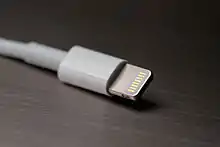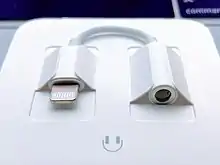Lightning (connector)
Lightning is a proprietary computer bus and power connector created and designed by Apple Inc. Introduced on September 12, 2012, to replace its predecessor, the 30-pin dock connector, the Lightning connector is used to connect Apple mobile devices like iPhones, iPads, and iPods to host computers, external monitors, cameras, USB battery chargers, and other peripherals. Using 8 pins instead of 30, Lightning is more dense than its predecessor, which was integrated with devices like the iPhone 4 and the iPad 2. The male Lightning connector is symmetrical (same pins on either side), so it can be inserted into a female Lightning port in either orientation.
 Top and down view of a Lightning cable, showing the 8-pin connector | |||
| Type | Data and power connector | ||
|---|---|---|---|
| Production history | |||
| Designer | Apple Inc. | ||
| Produced | 2012–present | ||
| Superseded | 30-pin dock connector | ||
| General specifications | |||
| Pins | 8 | ||
| Pin out | |||
 Pin out | |||
| Receptacle view | |||
| Pin 1 | GND | Ground | |
| Pin 2 | L0p | Lane 0 positive | |
| Pin 3 | L0n | Lane 0 negative | |
| Pin 4 | ID0 | Identification/control 0 | |
| Pin 5 | PWR | Power (charger or battery) | |
| Pin 6 | L1n | Lane 1 negative | |
| Pin 7 | L1p | Lane 1 positive | |
| Pin 8 | ID1 | Identification/control 1 | |
| Lane 0 and 1 may swap in IC of device connector (lanes don't swap if the accessory identification chip is connected to the ID0 pin) | |||
History
The Lightning connector was introduced on September 12, 2012, as an upgrade to the 30-pin dock connector. It would soon be integrated with all new hardware and devices that was to be announced at the same event.[1] The first compatible devices were the iPhone 5, the iPod Touch (5th generation), and the iPod Nano (7th generation).[2] The iPad (4th generation) and the iPad Mini (1st generation) were added as Lightning devices in October 2012.[3][4]
On November 25, 2012, Apple acquired the "Lightning" trademark in Europe from Harley-Davidson. Apple was given a partial transfer of the Lightning trademark, suggesting that Harley-Davidson likely retained the rights to use the name for motorcycle-related products.[5][6] Apple is the sole proprietor of the trademark and copyrights for the designs and specifications of the Lightning connector.
The iPad Pro, released in 2015, features the first Lightning connector supporting USB 3.0 host.[7] However, the only accessory that supports USB 3.0 is the new camera adapter. Normal USB-A - Lightning cables are still USB 2.0.
On October 30, 2018, Apple announced that their new range of iPad Pro models will replace Lightning with USB-C.[8]
Technology




Lightning is an 8-pin connector that carries a digital signal. Unlike the Apple 30 pin connector it replaces (and USB Type A or B connectors), the Lightning connector can be inserted either face up or face down. Each pin on the reverse side of the connector is connected to its directly opposite twin on the other side. Part of the processor's job is to route the power and data signals correctly whichever way up the connector is inserted.[9]
Apple offers various adapters that allow the Lightning connector to be used with other interfaces, such as 30-pin, USB, HDMI, VGA, and SD cards. The Lightning to 30-pin adapter supports only a limited subset of the available 30-pin signals: USB data, USB charging, and analog audio output (via the DAC inside of the adapter[10]).
Official Lightning connectors contain an authentication chip that made it difficult for third-party manufacturers to produce compatible accessories without being approved by Apple;[11] however, the authentication scheme has been cracked.[9]
The plug measures 6.7 mm by 1.5 mm.
Comparisons with microUSB
Apple has not publicly discussed microUSB, but various tech news websites state that Lightning might have been used instead of microUSB because of its compatibility with docks and speaker systems;[12] the ability to insert the cable in either direction for user convenience;[13] Apple wishing to maintain control over supply chain of accessories[14] and the ability to charge a licensing fee; and the mechanical weakness of USB connectors.[13] The optional supplemental standard USB On-The-Go allows USB devices to do this.[15]
On April 10, 2015, Apple announced a new line of MacBooks that featured USB-C, which has similarities with Lightning, and advantages over microUSB. USB-C, like Lightning, but unlike its predecessor microUSB, can be plugged in either direction. USB-C and Lightning are not interchangeable as they are entirely different pin-outs, protocols and connectors, and until the launch of the new MacBooks required adapters to work with each other.
Devices using Lightning connectors

The following Apple-made devices use Lightning connectors:
iPhone
iPad
iPod
Adapters
- Lightning to 30-pin Adapter
- Lightning to 30-pin Adapter (0.2 m)
- Lightning to Micro USB Adapter
- Lightning to USB Camera Adapter
- Lightning to USB 3 Camera Adapter
- Lightning to SD Card Camera Reader
- Lightning to VGA Adapter
- Lightning Digital AV Adapter
- Lightning to HDMI
- Lightning to 3.5 mm Headphone Jack Adapter[16]
- Lightning to USB (Power Delivery)
- Lightning to USB-C (Power Delivery)[17]
Accessories
- Apple Pencil (1st generation)
- Magic Keyboard
- Magic Mouse 2, Magic Trackpad 2
- Apple Watch magnetic charging dock
- Siri Remote for Apple TV (4th & 5th generation)
- AirPods and AirPods Pro charging cases
- EarPods with Lightning connector
- BeatsX Earphones
- Powerbeats Pro charging case
- Beats Pill+ speaker
- iPhone Lightning dock
- Beats Solo Pro headphones
- SteelSeries Nimbus game controller
Reception
Many reviewers have criticized Apple for continuing to include a Lightning port on their products instead of moving to a more modern, universal port such as USB-C.[18] Apple has stated that they continue to use Lightning because replacing it "would create an unprecedented amount of electronic waste".[19][20] However, some users and reviewers have speculated that it is simply because Apple wants to continue selling its proprietary chargers and accessories.[21]
See also
References
- Pollicino, Joe (September 12, 2012). "Apple's September 12th event roundup: iPhone 5, new iPods, iOS 6, Lightning and everything else". Engadget. Retrieved October 5, 2012.
- Dillet, Romain (September 12, 2012). "The iPhone 5 Comes With The New "Lightning" Connector". TechCrunch. Retrieved September 27, 2012.
- Schultz, Marianne (October 23, 2012). "Apple Announces Fourth-Generation iPad with Lightning Connector, New A6X Chip". MacRumors. Retrieved December 2, 2012.
- "iPad mini Technical Specifications". Apple Inc. December 2, 2012. Retrieved October 23, 2012.
- Goldman, David (November 26, 2012). "Apple bought Lightning trademark from Harley-Davidson". CNNMoney.com. Retrieved November 29, 2012.
- "Apple acquired Lightning trademark from Harley-Davidson". Apple Insider.
- "iPad Pro 12.9 Teardown". iFixit.
- https://www.news.com.au/technology/gadgets/tablets/apple-unveils-new-ipads-macs-and-mac-minis-at-event-in-new-york/news-story/29f518ef7745924673dc44d5f3dbc225
- Gary Marshall (October 24, 2012). "Apple Lightning connector: what you need to know". techradar.
- Eric Slivka (October 11, 2012). "Apple's Lightning to 30-Pin Adapter Torn Apart, Reveals Several Chips and Copious Glue". MacRumors. Retrieved September 9, 2016.
- Foresman, Chris (October 3, 2012). "Apple revising MFi program to limit third-party Lightning accessories". Ars Technica. Retrieved October 3, 2012.
- "Engineer explains why Apple went with Lightning instead of Micro USB". idownloadblog.com. September 14, 2012. Retrieved October 18, 2013.
- "Hardware comparison: Lightning connector vs MicroUSB connector". pocketables.com. December 20, 2012. Retrieved October 18, 2013.
- "Made For iPhone manufacturers may have to comply with Apple's supplier responsibility code". Engadget. Retrieved July 3, 2015.
- "c|net: Clever adapter connects USB accessories to your Android device"
- "Lightning to 3.5 mm Headphone Jack Adapter". Apple. Retrieved January 25, 2017.
- "USB Type C to Lightning Cable". Apple. Retrieved December 25, 2017.
- "Hey Apple, now would be a great time to ditch Lightning and get with USB-C". Android Authority. January 22, 2020. Retrieved February 3, 2021.
- "Apple says losing Lightning port will create waste". BBC News. January 23, 2020. Retrieved February 3, 2021.
- "Why iPhone 12 still won't be going USB-C". iMore. May 25, 2020. Retrieved February 3, 2021.
- Eadicicco, Lisa. "Apple is under pressure to kill the iPhone's Lightning charger — but here's why that probably won't happen anytime soon". Business Insider. Retrieved February 3, 2021.
Further reading
| Wikimedia Commons has media related to Lightning (connector). |
- Wingfield, Nick & Chen, Brian X. (May 5, 2013). "Accessories No Longer Tethered to Apple". The New York Times.
